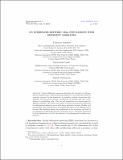Files in this item
On interfaces between cell populations with different mobilities
Item metadata
| dc.contributor.author | Lorenzi, Tommaso | |
| dc.contributor.author | Lorz, Alexander | |
| dc.contributor.author | Perthame, Benoit | |
| dc.date.accessioned | 2017-11-02T00:31:56Z | |
| dc.date.available | 2017-11-02T00:31:56Z | |
| dc.date.issued | 2017-03 | |
| dc.identifier | 242505183 | |
| dc.identifier | 7f4b4815-b8e8-4b32-ae53-384c1b890afa | |
| dc.identifier | 85010207319 | |
| dc.identifier | 000390102700013 | |
| dc.identifier.citation | Lorenzi , T , Lorz , A & Perthame , B 2017 , ' On interfaces between cell populations with different mobilities ' , Kinetic and Related Models , vol. 10 , no. 1 , pp. 299-311 . https://doi.org/10.3934/krm.2017012 | en |
| dc.identifier.issn | 1937-5093 | |
| dc.identifier.uri | https://hdl.handle.net/10023/11980 | |
| dc.description.abstract | Partial differential equations describing the dynamics of cell population densities from a fluid mechanical perspective can model the growth of avascular tumours. In this framework, we consider a system of equations that describes the interaction between a population of dividing cells and a population of non-dividing cells. The two cell populations are characterised by different mobilities. We present the results of numerical simulations displaying two-dimensional spherical waves with sharp interfaces between dividing and non-dividing cells. Furthermore, we numerically observe how different ratios between the mobilities change the morphology of the interfaces, and lead to the emergence of finger-like patterns of invasion above a threshold. Motivated by these simulations, we study the existence of one-dimensional travelling wave solutions. | |
| dc.format.extent | 910953 | |
| dc.language.iso | eng | |
| dc.relation.ispartof | Kinetic and Related Models | en |
| dc.subject | Cell populations | en |
| dc.subject | Tissue growth | en |
| dc.subject | Cancer invasion | en |
| dc.subject | Interfaces | en |
| dc.subject | Travelling waves | en |
| dc.subject | Pattern formation | en |
| dc.subject | QA Mathematics | en |
| dc.subject | QH301 Biology | en |
| dc.subject | RC0254 Neoplasms. Tumors. Oncology (including Cancer) | en |
| dc.subject | T-NDAS | en |
| dc.subject | SDG 3 - Good Health and Well-being | en |
| dc.subject.lcc | QA | en |
| dc.subject.lcc | QH301 | en |
| dc.subject.lcc | RC0254 | en |
| dc.title | On interfaces between cell populations with different mobilities | en |
| dc.type | Journal article | en |
| dc.contributor.institution | University of St Andrews. Applied Mathematics | en |
| dc.identifier.doi | https://doi.org/10.3934/krm.2017012 | |
| dc.description.status | Peer reviewed | en |
| dc.date.embargoedUntil | 2017-11-01 |
This item appears in the following Collection(s)
Items in the St Andrews Research Repository are protected by copyright, with all rights reserved, unless otherwise indicated.

